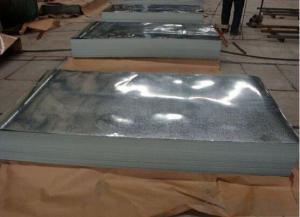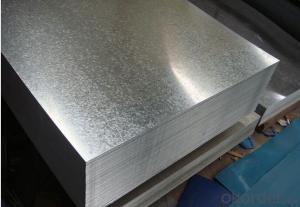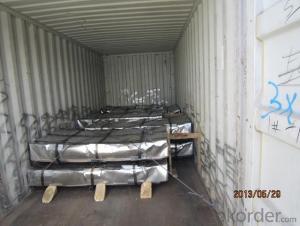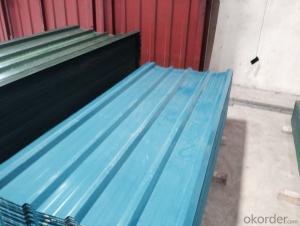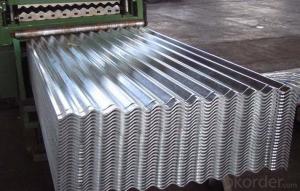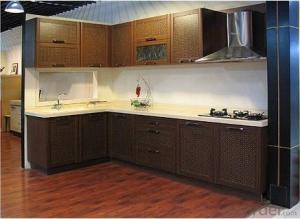High Quality of Cold Rolled Steel Sheet from China
- Loading Port:
- Shanghai
- Payment Terms:
- TT OR LC
- Min Order Qty:
- 100 m.t.
- Supply Capability:
- 5000 m.t./month
OKorder Service Pledge
OKorder Financial Service
You Might Also Like
1.Structure of Cold Rolled Steel Description:
The raw material of cold rolled steel coil/sheet is high quality hot rolled product, and after pickling continuous rolling, degreasing, annealing,skin pass,slitting and cut to length line etc. Along with it many kinds of new technology and new process of global cold rolling production have been applied. Therefore the quality of the goods could be guaranteed. The product is widely used in outdoor and interior decoration, furnishing manufacturing, home appliance, automobile etc.
2.Main Features of the Cold Rolled Steel:
• Excellent process capability
• Smooth and flat surface
• Workability, durability
• Excellent heat resistance performance
• High strength
• Good formability
• Good visual effect
3.Cold Rolled Steel Images
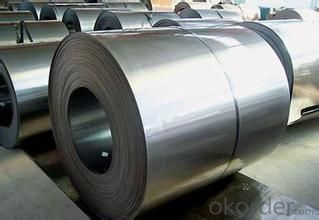
4.Cold Rolled Steel Specification
Standard:AISI,ASTM,DIN,GB,JIS,JIS G3302 ASTM 653M EN10142
Grade: Q195~Q345
Thickness: 0.16mm~1.5mm,0.16-1.5mm
Width: 1250,600-1250mm
Coil weight:3-12 MT
Coil ID:508/610mm
Chemical composition:
C | Si | Mn | Cr | Ni | P | S |
0.150 | 0.476 | 11.231 | 12.50 | 0.900 | 0.039 | 0.010
|
5.FAQ of Cold Rolled Steel
We have organized several common questions for our clients,may help you sincerely:
1.How about your company?
A world class manufacturer & supplier of castings forging in carbon steel and alloy steel,is one of the large-scale professional investment casting production bases in China,consisting of both casting foundry forging and machining factory. Annually more than 8000 tons Precision casting and forging parts are exported to markets in Europe,America and Japan. OEM casting and forging service available according to customer’s requirements.
2.How to guarantee the quality of the products?
We have established the international advanced quality management system,every link from raw material to final product we have strict quality test;We resolutely put an end to unqualified products flowing into the market. At the same time, we will provide necessary follow-up service assurance.
3. How long can we receive the product after purchase?
Usually within thirty working days after receiving buyer’s advance payment or LC. We will arrange the factory manufacturing as soon as possible. The cargo readiness usually takes 15-25 days, but the shipment will depend on the vessel situation.
- Q:What is the standard thickness of steel sheets?
- The standard thickness of steel sheets varies depending on the specific application and industry requirements. However, commonly used thicknesses range from 0.4mm to 3mm for general purposes, and thicker sheets can be found for specialized applications.
- Q:What is the typical thickness tolerance for steel sheets?
- The typical thickness tolerance for steel sheets can vary depending on the specific industry and application requirements. However, in general, the standard thickness tolerance for steel sheets is typically around ±0.005 to ±0.010 inches (0.13 to 0.25 mm). This means that the actual thickness of the steel sheet can deviate within this range from the specified nominal thickness. It is important to note that certain industries or applications may have more stringent tolerance requirements, especially when precision is critical. In such cases, the tolerance may be tighter, ranging from ±0.001 to ±0.003 inches (0.025 to 0.076 mm). Additionally, specialized steel products or specific customer requirements may also result in different tolerance specifications. To ensure compliance with the desired thickness tolerance, manufacturers employ strict quality control measures such as precise calibration of equipment, regular inspection of raw materials, and comprehensive testing procedures. This helps to maintain the integrity and reliability of steel sheets for various applications in industries such as automotive, construction, manufacturing, and more.
- Q:Are steel sheets resistant to radiation or electromagnetic interference?
- Steel sheets are not inherently resistant to radiation or electromagnetic interference. However, their thickness can provide some level of shielding against certain types of radiation, such as gamma radiation. For protection against electromagnetic interference, additional layers or coatings specifically designed to block or absorb electromagnetic waves may be required.
- Q:What is the average cost of installing steel sheets?
- The average cost of installing steel sheets can vary depending on several factors such as the size and thickness of the sheets, the complexity of the installation, and the location. However, on average, the cost can range from $1,000 to $5,000 for a standard installation.
- Q:What are the different color options available for steel sheets?
- Steel sheets can be available in a variety of color options, depending on the specific requirements and preferences. Some common color options for steel sheets include: 1. Natural Steel: This is the most common color option for steel sheets, which is the natural color of the steel surface without any additional coating or treatment. It has a silver-grey appearance. 2. Galvanized Steel: Galvanization is a process in which a protective zinc coating is applied to the steel sheet. This results in a shiny silver color, providing enhanced corrosion resistance. 3. Coated Steel: Steel sheets can be coated with various materials to provide different colors and additional protection. These coatings can include polyester, silicone polyester, polyvinylidene fluoride (PVDF), or plastic film coatings. These coatings can be available in a wide range of colors, including white, red, blue, green, and more. 4. Painted Steel: Steel sheets can also be painted with various types of paint, such as epoxy, polyurethane, or acrylic. This allows for a virtually unlimited range of color options, including standard colors like black, grey, white, as well as custom colors to match specific requirements. It is important to note that the availability of different color options may vary depending on the specific supplier and the intended application of the steel sheets. Additionally, different color options may also have different performance characteristics, such as improved resistance to UV radiation or enhanced durability.
- Q:How do steel sheets perform in terms of thermal expansion?
- Steel sheets have a relatively low coefficient of thermal expansion, meaning they expand and contract minimally when exposed to temperature changes. This property makes them suitable for various applications where dimensional stability is crucial, as they are less likely to warp or deform due to thermal expansion.
- Q:What is the difference between a steel sheet and a steel plate?
- The differences between a steel sheet and a steel plate are significant. Firstly, the thickness of a steel sheet is typically less than 6mm, whereas a steel plate is generally thicker, measuring 6mm or more. This discrepancy in thickness is primarily attributed to the intended purpose of each product. Steel sheets are commonly used in scenarios where weight and flexibility are crucial, such as in the production of automobile bodies or appliances. Conversely, steel plates are frequently employed in heavy-duty constructions such as bridges, buildings, or machinery, where strength and durability are of utmost importance. Another distinction can be found in the manufacturing process. Steel sheets are usually created through hot rolling, which involves heating the steel above its recrystallization temperature and subsequently passing it between rollers to achieve the desired thickness. On the other hand, steel plates can be made through either hot rolling or cold rolling processes. Cold rolling entails passing the steel through rollers at room temperature, resulting in a more precise and smoother surface finish. Furthermore, the size of steel sheets and plates also differs. Steel sheets are often standardized in terms of width and length, making them more manageable and easier to transport. In contrast, steel plates are available in various sizes and dimensions, providing greater customization options to suit specific project requirements. To summarize, the key distinctions between a steel sheet and a steel plate lie in their thickness, manufacturing process, and intended use. Steel sheets are thinner and lighter, while steel plates are thicker and utilized in heavy-duty applications that demand strength and durability.
- Q:What are the common applications of galvannealed steel sheets?
- Galvannealed steel sheets are commonly used in various industries for applications such as automotive body parts, appliances, building materials, electrical enclosures, and HVAC systems.
- Q:How are steel sheets coated for corrosion resistance?
- Steel sheets are commonly coated for corrosion resistance using a process called galvanization. Galvanization involves applying a layer of zinc to the surface of the steel sheet. This can be done through either hot-dip galvanization or electro-galvanization. In hot-dip galvanization, the steel sheet is immersed in a bath of molten zinc, which adheres to the surface of the steel through a metallurgical reaction. The zinc coating forms a protective barrier that prevents moisture and oxygen from reaching the steel, thus inhibiting corrosion. Electro-galvanization, on the other hand, involves passing an electric current through the steel sheet while it is immersed in a zinc electrolyte solution. The electric current causes the zinc ions in the solution to be attracted to the steel surface, forming a thin layer of zinc coating. This method is typically used for thinner steel sheets or when a more precise and controlled coating thickness is required. Both hot-dip galvanization and electro-galvanization provide effective corrosion resistance to steel sheets. The zinc coating acts as a sacrificial layer, meaning that it corrodes first before the steel underneath. This sacrificial protection extends the lifespan of the steel sheet and prevents rust from forming. Additionally, the zinc coating can also provide a decorative finish, making it suitable for both practical and aesthetic purposes. Overall, the process of galvanization is a widely used and effective method for coating steel sheets to enhance their corrosion resistance and durability.
- Q:Can steel sheets be used for industrial machinery or equipment?
- Yes, steel sheets can be commonly used for industrial machinery or equipment due to their excellent strength, durability, and resistance to wear and tear. They are suitable for various applications such as fabrication, construction, automotive, and manufacturing industries. Steel sheets provide stability and structural integrity, making them a preferred choice for manufacturing robust and reliable machinery and equipment.
1. Manufacturer Overview |
|
|---|---|
| Location | |
| Year Established | |
| Annual Output Value | |
| Main Markets | |
| Company Certifications | |
2. Manufacturer Certificates |
|
|---|---|
| a) Certification Name | |
| Range | |
| Reference | |
| Validity Period | |
3. Manufacturer Capability |
|
|---|---|
| a)Trade Capacity | |
| Nearest Port | |
| Export Percentage | |
| No.of Employees in Trade Department | |
| Language Spoken: | |
| b)Factory Information | |
| Factory Size: | |
| No. of Production Lines | |
| Contract Manufacturing | |
| Product Price Range | |
Send your message to us
High Quality of Cold Rolled Steel Sheet from China
- Loading Port:
- Shanghai
- Payment Terms:
- TT OR LC
- Min Order Qty:
- 100 m.t.
- Supply Capability:
- 5000 m.t./month
OKorder Service Pledge
OKorder Financial Service
Similar products
New products
Hot products
Hot Searches
Related keywords
